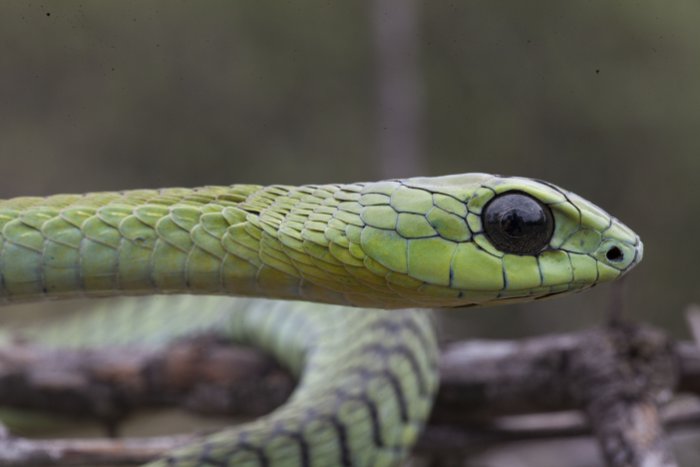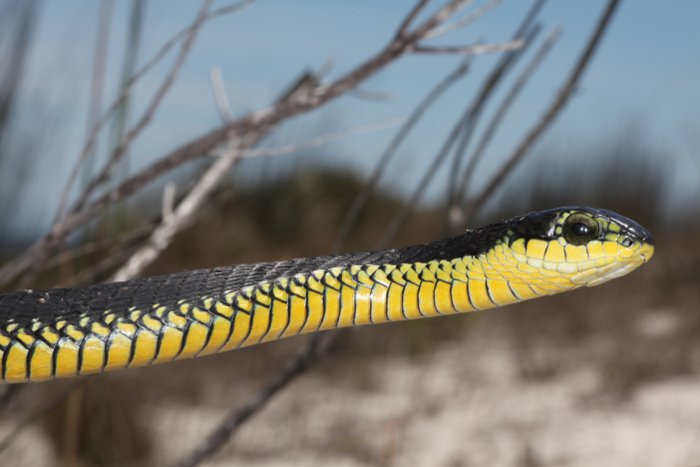One of the most frequently asked questions about snakes is which one is the most poisonous. Most snakes are not poisonous but venomous. Some plants, like certain mushrooms, are poisonous if eaten, while snake venom has to be envenomated for the venom to take effect. So, generally speaking, provided that you do not have major lacerations in the throat or open wounds in the stomach, you can safely swallow snake venom without any ill effect. Not that I am recommending this as some people may well be allergic to snake venom and may go into anaphylactic shock. Written by: Johan Marais of the African Snakebite Institute

So then the question changes – which snake is the most venomous? This is quite a debate as the most venomous snake in Africa is often not considered very dangerous – the boomslang (Dispholidus typus). Drop for drop, the boomslang has the most potent venom of any snake in Africa, and the amount of venom that it requires to kill a human is so small that one can barely see it with the naked eye. There are seldom more than one or two boomslang bites a year in South Africa, and the victims are often snake handlers. The snake is unlikely to bite, and if severely provoked, it will inflate its neck, and once it does this it will strike out with intent. The boomslang is back-fanged with short fixed fangs far back in the mouth, and, like most snakes, it can open its mouth very wide – up to 170˚- and easily latch onto an arm or a leg. While most venomous snakes have full control over their venom glands, back-fanged snakes have quite primitive glands, and to envenomate their prey they need to strike a few times, putting pressure on the venom glands to ensure that venom is released from the duct. A boomslang will often bite a chameleon, release it, bite it again and repeat the process a few times. This is to make sure that envenomation takes place. It is not uncommon for people to be bitten by a boomslang (or any other snake, for that matter) without being envenomated; this is known as a dry bite.


Boomslang venom is haemotoxic, affecting the blood clotting mechanism, and very slow to take effect. Victims seldom experience serious symptoms in the first few hours, and untreated cases may result in human fatalities after 12 hours or even after a few days. There is a monovalent anti-venom made especially for boomslang envenomation, and this is kept at the South African Vaccine Producers and supplied when required.
In Africa, where there are around 20 000 snakebite deaths a year, the main culprit is the saw-scales viper (also known as the carpet viper) of the genus Echis. It has a potent haemotoxic venom that affects the blood clotting mechanism, but part of the problem is a lack of anti-venom and medical facilities in northern Africa.

In Southern Africa, the Mozambique spitting cobra (Naja mossambica) accounts for the majority of serious snakebites, followed by the puff adder (Bitis arietans) and the stiletto snake (Atractaspis bibronii). These three snakes account for more than 80% of our serious snakebites. Still, the mortality rate is extremely low as the venoms are cytotoxic, causing severe pain, local swelling and tissue damage and the majority of victims are treated successfully. However, some may lose limbs or suffer severe tissue damage. The stiletto snake has not caused any human deaths in Southern Africa, but those further north in Africa have.



Of our cobras, the Cape cobra (Naja nivea) has the most potent venom and, along with the black mamba (Dendroaspis polylepis), accounts for the most human fatalities. Information on snakebite deaths is hard to come by but totals around 12-24 deaths yearly in Southern Africa. These snakes have predominantly neurotoxic venom that rapidly affects breathing.

As for the most dangerous snake in Africa or the world, I would go with the black mamba. It is by far the largest venomous snake in Africa, historically reaching 4.5 m, although specimens over 3.8 m are unheard of nowadays. Due to its size, it has a lot of venom, it bites readily (often more than once), the venom absorbs rapidly and may have a severe effect on breathing 20 minutes after a serious bite. Although often labelled an aggressive snake, the black mamba is very shy, nervous, and quick to escape when it has the choice, but if cornered or hurt, it will not hesitate to strike. Another problem is that because of its length, it may bite quite high up in the chest region, and such a bite would be far more severe than a bite on an extremity.

There is no two-step snake – the mythical snake that bites, and you die after two steps. A severe untreated bite from a black mamba can kill a human in anything from 4 – 16 hours and, in severe cases, within an hour – but that is unusual. People die within minutes of a bee sting or eating a peanut, but that is the exception and not the rule.
ALSO READ: Snakes – everything you need to know
To comment on this story: Login (or sign up) to our app here - it's a troll-free safe place 🙂.![]()






